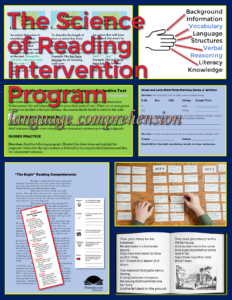Scarborough’s Other Side of the Rope
We all know about word recognition, but what about Scarborough’s Other Side of the Rope?
 In 2001, Dr. Hollis Scarborough, a developmental psychologist, helped parents and teachers visualize the complexity, interconnectedness, and development of skilled reading over time with her reading rope infographic. The reading rope splits into two major strands: an upper language comprehension strand strand and a lower word recognition strand. Unlike other posts, I won’t share the visual to respect the good doctor’s copyright. I’ve spoken to Hollis and she is rightfully protective of that unaltered image!
In 2001, Dr. Hollis Scarborough, a developmental psychologist, helped parents and teachers visualize the complexity, interconnectedness, and development of skilled reading over time with her reading rope infographic. The reading rope splits into two major strands: an upper language comprehension strand strand and a lower word recognition strand. Unlike other posts, I won’t share the visual to respect the good doctor’s copyright. I’ve spoken to Hollis and she is rightfully protective of that unaltered image!
Anyway, it is important to interpret the rope as it was originally intended. Dr. Scarborough used what were known as “pipe cleaners” (color coated wires used for arts and crafts) to intertwine each of these two strands. In other words, the word recognition and language comprehension components of reading instruction are not silos unto themselves.
As Gough and Tunmer describe their relationship, the product of word recognition and language comprehension is “skilled reading” (1986).
As is often said, but less often practiced, both strands are essential to effective reading instruction. However, most of us who adhere to the science of reading do tend to focus on the lower word recognition strand. Now, that is not to say that Balanced Literacy advocates are right when they characterize the science of reading movement as “phonics only.” There is certainly more to word recognition than phonics.
However, both camps (Balanced Literacy and Science of Reading) could certainly benefit from a renewed focus on language comprehension.
Now, why have reading teachers tended to shy away from teaching language comprehension? I’ll posit three answers:
- The components of language comprehension tend to be more abstract than those of word recognition. For example, teaching literary devices, such as metaphor, is less concrete than, say teaching the spellings of the long /e/ sound.
- Beginning reading teachers tend to be primary teachers (as opposed to reading intervention, EL, and ESL teachers). Primary teachers, understandably, tend to have more pre-service and professional development in word recognition than they do in language comprehension. And even secondary teachers will admit to never receiving university training in all facets of language comprehension: syntax and grammar come to mind.
- Teaching language comprehension is tough.
Language comprehension is one of the most automatic tasks that humans perform. Yet it is also one of the most complex, requiring the simultaneous integration of many different types of information, such as knowledge about letters and their sounds, spelling, grammar, word meanings, and general world knowledge. In addition, general cognitive abilities such as attention monitoring, inferencing, and memory retrieval organize this information into a single meaningful representation.
Van Dyke, 2016
My take is that it’s time to practice what we preach! Take the time to learn how to teach language comprehension and allocate instructional minutes to doing so.
The author’s The Science of Reading Intervention Program provides evidence-based, speech to print instructional resources (digital and print formats) in its word recognition component to accelerate reading achievement with solid phonemic awareness, phonics, spelling, vocabulary, fluency, and comprehension practice. The 54 decodables (one for each lesson) feature teenage characters and plots with word fluency, heart words, and comprehension questions. Sound boxes, personal sound walls, and speech to print phonics games for review.
The language comprehension component (the other side of the rope) includes lessons in syntax in reading and writing, advanced vocabulary/morphology, literary components, and executive function skills. Also, advanced fluency practice with expository modeled readings on YouTube.
Lastly, assessment-based instructional resources for “second chance” and transfer students.
*****

Language Comprehension